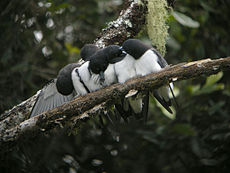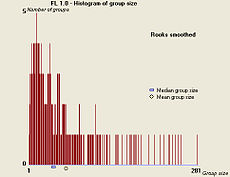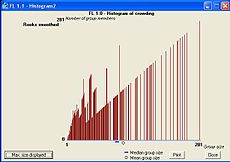- Group size measures
-
Many animals, including humans, tend to live in groups, herds, flocks, bands, packs, shoals, or colonies (hereafter: groups) of conspecific individuals. The size of these groups, as expressed by the number of participant individuals, is an important aspect of their social environment. Group size tend to be highly variable even within the same species, thus we often need statistical measures to quantify group size and statistical tests to compare these measures between two or more samples. Unfortunately, group size measures are notoriously hard to handle statistically since groups size values typically exhibit an aggregated (right-skewed) distribution: most groups are small, few are large, and a very few are very large.
Statistical measures of group size roughly fall into two categories.
Contents
Outsiders’ view of group size
Animal group size data tend to exhibit aggregated (right-skewed) distributions, i.e. most groups are small, a few are large, and a very few are very large. The distribution of rook colony sizes in Normandy, 1999-2000 (smoothed). Mean colony size is 60 pairs. (Data from Debout, 2003)
- Group size is the number of individuals within a group;
- Mean group size , i.e. the arithmetic mean of group sizes averaged across groups;
- Confidence interval for mean group size;
- Median group size, i.e. the median of group sizes calculated across groups;
- Confidence interval for median group size.
Insiders’ view of group size
As Jarman (1974) pointed out, average individuals live in groups larger than average – simply because the groups smaller than average have fewer individuals than the groups larger than average. (Except for an unrealistic case when all groups are of equal size.) Therefore, when we wish to characterize a typical (average) individual’s social environment, we should not apply the outsiders’ view of group size. Reiczigel et al. (2008) proposed the following measures:
- Crowding is the number of individuals within a group (equals to group size: 1 for a solitary individual, 2 for both individuals in a group of 2, etc.);
- Mean crowding, i.e. the arithmetic mean of crowding measures averaged across individuals (this was called "Typical Group Size" according to Jarman's 1974 terminology);
- Confidence interval for mean crowding.
Although large rook colonies are rare, however, they still incorporate a large proportion of individuals. Insiders' view of the same data set as above: the distribution of individuals (pairs) across colonies of different sizes. An average individual breeds in a colony of about 120 pairs, far larger than mean colony size.
Statistical methods
Due to the aggregated (right-skewed) distribution of group members among groups, the application of parametric statistics would be misleading. Another problem arises when analyzing crowding values. Crowding data consist of nonindependent values, or ties, which show multiple and simultaneous changes due to a single biological event. (Say, all group members' crowding values change simultaneously whenever an individual joins or leaves.)
The paper by Reiczigel et al. (2008) discusses the statistical problems associated with group size measures (calculating confidence intervals, 2-sample tests, etc.) and offers a free statistical toolset (Flocker 1.1) to handle them in a user-friendly manner.
Literature
- Debout G 2003. Le corbeau freux (Corvus frugilegus) nicheur en Normandie: recensement 1999 & 2000. Cormoran, 13, 115–121.
- Jarman PJ 1974. The social organisation of antelope in relation to their ecology. Behaviour, 48, 215–268.
- Reiczigel J, Lang Z, Rózsa L, Tóthmérész B 2008. Measures of sociality: two different views of group size. Animal Behaviour, 75, 715–721.
See also
Size of groups, organizations, and communities
External links
Gallery
-
Gannet colony
-
African buffalo herd
-
Sheep flock
-
Red-billed Quelea flock
-
Bluestripe snapper schooling.
-
Common Crane flock
-
European Paper Wasp colony
Swarming Swarm algorithms - Agent-based models
- Ant colony optimization
- Ant robotics
- Artificial Ants
- Bees algorithm
- Bee colony optimization
- Boids
- Crowd simulation
- Firefly algorithm
- Glowworm swarm optimization
- Particle swarm optimization
- Self-propelled particles
- Swarm intelligence
- Swarm (simulation)

Biological swarming - Agent-based model in biology
- Bait ball
- Collective animal behavior
- Feeding frenzy
- Flock
- Flocking
- Herd
- Herd behavior
- Mixed-species foraging flock
- Mobbing behavior
- Pack hunter
- Patterns of self-organization in ants
- Sardine run
- Shoaling and schooling
- Sort sol
- Swarming behaviour
- Swarming (honey bee)
- Swarming motility
Animal migration Swarm robotics Related topics
Wikimedia Foundation. 2010.













